If there is one attraction that is very underrated in Heidelberg, it must be Heiligenberg (Holy Mountain).
The starting point of what we know as Heidelberg today, this hill has many interesting ruins and things to see and it can actually be possible to get it to yourself as the throngs descend on Heidelberg’s Old Town and the castle.
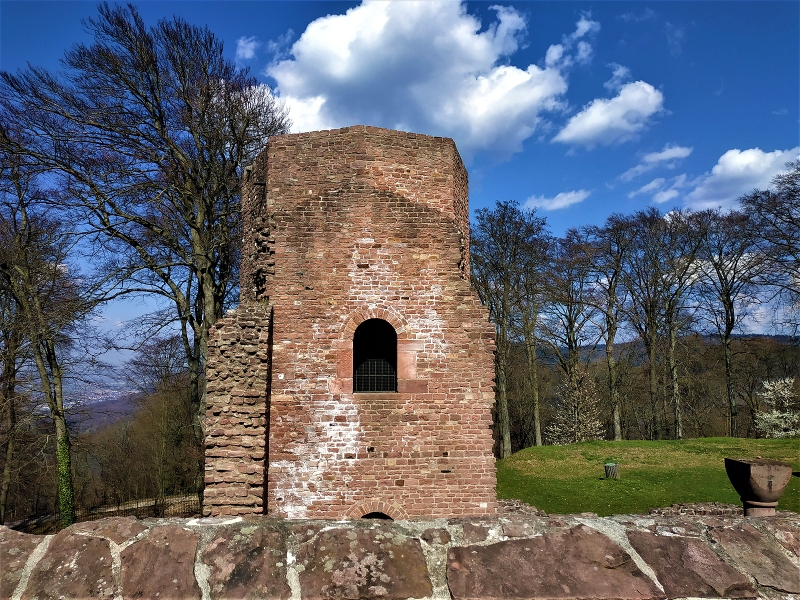
Heiligenberg Heidelberg is an enjoyable walk from the Old Town and really takes you into a different world among the forest and old ruins. It makes for a very enjoyable half day trip in Heidelberg and is easy to explore by yourself with ruins from the Celts, Romans, Middle Ages and right up to 1935.
Below, I cover everything you need to know about visiting Heiligenberg including some background history, what you can see when you visit, how to get here, entry fees and more.
So keep reading and make sure you add Heiligenberg to your must-do list in Heidelberg!
You can also find our full guide to Heidelberg here.
Love Germany? Click here to download your free guide to ALL of Germany’s Amazing UNESCO sites. See all 52 of them!
Heiligenberg History
Heiligenberg has been home to humans for a long time with pottery findings proving that it’s been inhabited from at least 5500-5100BC.
Celts settled here during the first millennium BC. They built a fortress here in the 5th century BC. This settlement was the political and cultural capital of the region from around this time to around 200BC. Iron ore was already being mined here in this period too.
The Romans came here next and considered an area of the mountain sacred. They built shrines and temples here on top of the old remains of the Celts. In fact, the ruins of St Michael’s Monastery, that you can see here today, were built on top of a Roman temple to Mercury and parts of it can be seen.
There have been some finds here from the 4th and 5th centuries, but in the late 6th century is when the mountain was resettled again. Christian burials started taking place here in the late 7th century and stone buildings were built over the old Roman shrines.
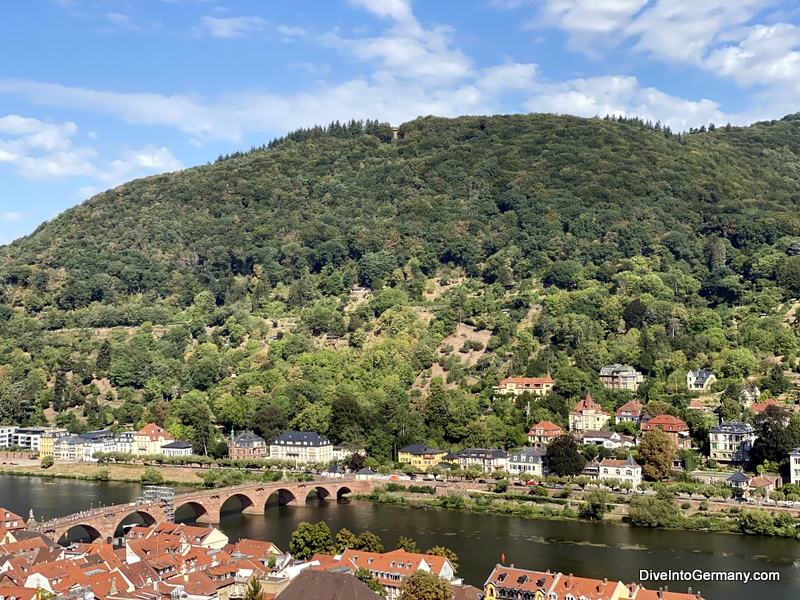
The first church was built here in 870 which later became St Michael’s Monastery in 1023. There is evidence of an early Romanesque church from the late 10th century. There are also remains of other religious buildings over the years.
By the 15th century, the remaining monasteries had become ruins and the area was largely abandoned until 1935. At this time, an amphitheatre called Thingstätte was constructed here by the Nazi Party and used for propaganda.
Parts of buildings have been removed over time, although thankfully since 2012, Heiligenberg has become protected by the state.
Heiligenberg Heidelberg Review – Visiting Today
Heiligenberg Germany is an easy place to visit today as it’s located very close to Heidelberg’s Old Town (more about the location and how to get there below). This mountain rises up 440 metres so it’s not so hard to walk up and enjoy. It’s also possible to drive up or get a bus.
We walked up from the Old Town and as part of a walk along the Philosopher’s Way as well (read about that here). We spent a few hours walking around, exploring the sites and having lunch at the restaurant mentioned below.
I talk more about the walk below.
Below are the ruins and attractions on Heidelberg Heiligenberg that you can see today. I have listed them in the order you’ll meet them as you walk up the hill.
Monastery of St. Stephan
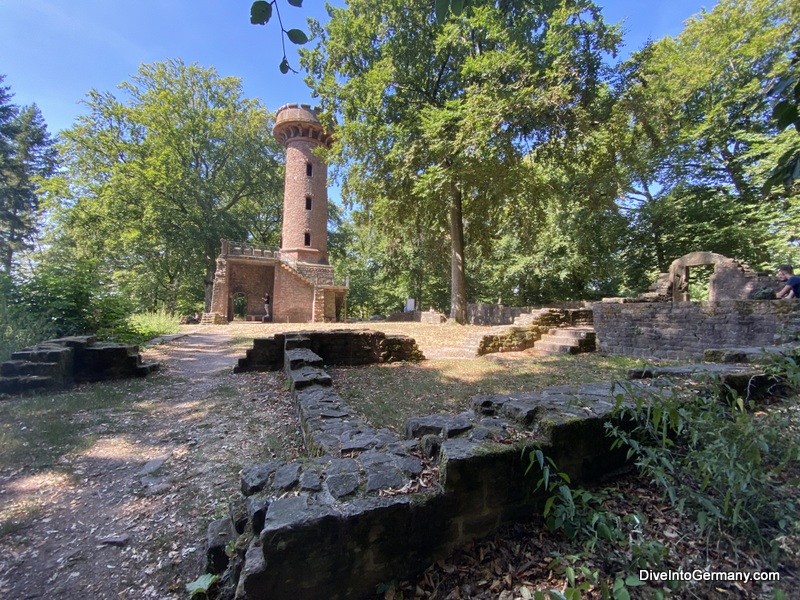
The first attraction when walking up the hill are the ruins of the Monastery of St Stephans.
The Monastery of St Stephans started as an outpost of the Monastery of St Michaels (coming up) after Benedictine Arnold built a hermitage and chapel on this spot in 1090.
Four years later, more buildings were added and it was a good observation point thanks to the cutting down of the forest that occurred to build and heat what became a new monastery.
Today, not much survives, but there is Heiligenbergturm (Heiligenberg Tower) which was built in 1885 from the ruins. You can climb up inside and there are great views over to Heidelberg Castle.
Heidenloch (Heathen Hole)

Basically across the road from the Monastery of St Stephans is Heidenloch (or Heathen Hole in English). It’s easy to miss so keep a look out for small hut over a hole.
Today, it is a shaft which is 55 metres deep with a diameter of between 3 – 4 metres with a latticed lid for a cover. You can take a look from the top, although it is not that interesting as you’ll just see a hole.
More interesting is its past.
No one knows who created Heidenloch and what its purpose was. The best theory is that people in the prehistoric or Roman periods were looking for water. Since then, it has been modified at various times.

The bottom was lined with bricks at some point. At another point, it was half filled with rubble and objects from monasteries. 22 metres down, there is a portrait of a woman carved into the wall of the shaft.
There are some information boards in the hut in German (Google translate is your friend).
Thingstätte
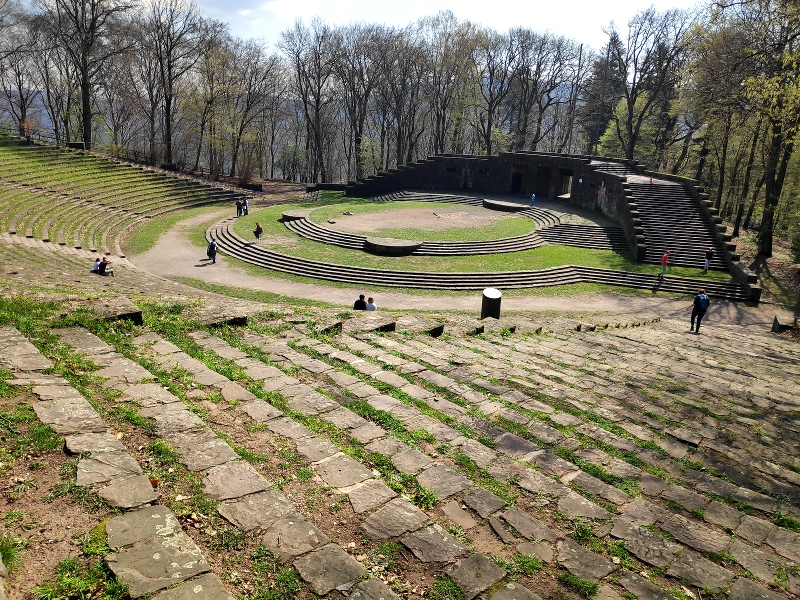
Thingstätte is a more recent ruin on Heiligenberg.
Thingstätte is an amphitheatre. It was completed in 1935. Its construction was part of the Thingspial movement which was started by the Nazi Minister of Propaganda, Joseph Goebbels. The idea was that they would be massive outdoor settings built for propaganda events.
A staggering amount were planned – over 100 – but only 45 were completed including this Thingstätte in Heidelberg on the Heiligenberg. This was chosen specifically because they liked to build them at places of historical significance or on top of ruins. From this viewpoint, this was a good choice of location being the place where Heidelberg began.

This Thingstätte seats 8,000 people with standing room for another 15,000.
Today, it is a public park and you can see what remains and explore this site by foot.
Despite reading all about this place beforehand and seeing many photos, I was still blown away by how absolutely massive it is. Take the time to check it out and explore.
Monastery of St. Michael
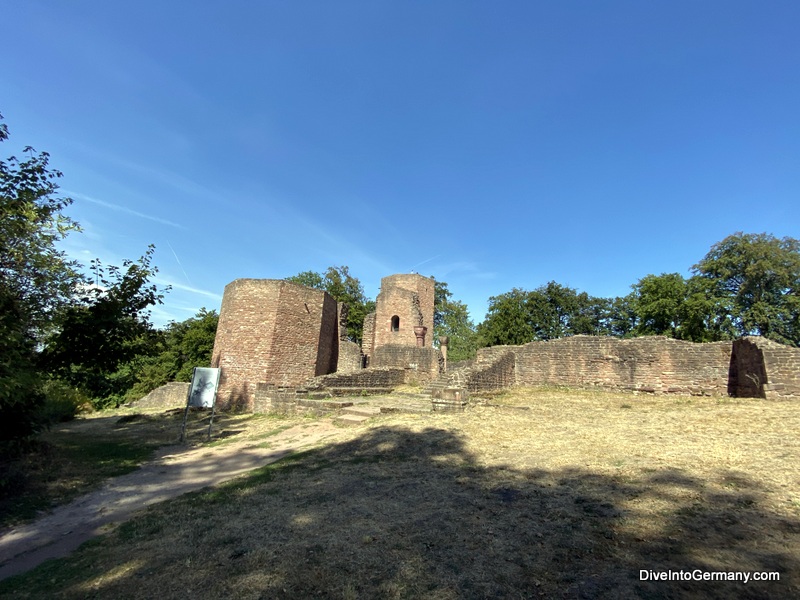
At the top of the hill are my favourite ruins, the ruins of St Michael’s Monastery. This was built in 1023 on the remains of a church built in 870. This church was built on earlier ruins and it’s possible to see Roman and Celtic remains at this spot.
Monks continued to live here until 1503. At this time, the steeple collapsed which unfortunately killed the final three monks in their beds. At this time, the monastery was abandoned.
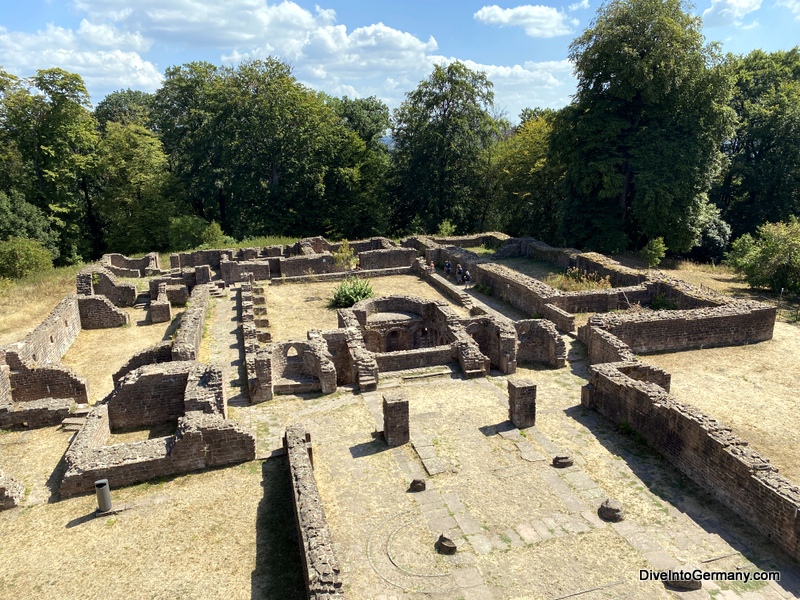
Today, you can explore the ruins including ascending the two towers. It’s a surprisingly large site and there are a couple of information boards as well as a map of the site.
As you walk around, there are signs to tell you what part of the monastery you are in.
Unfortunately, this doesn’t give any real context to what you are seeing and I would have loved a guide here to really soak in the history of the place.
Still, it is definitely worth exploring on your journey around Heiligenberg and is a highlight.
Heiligenberg Restaurant
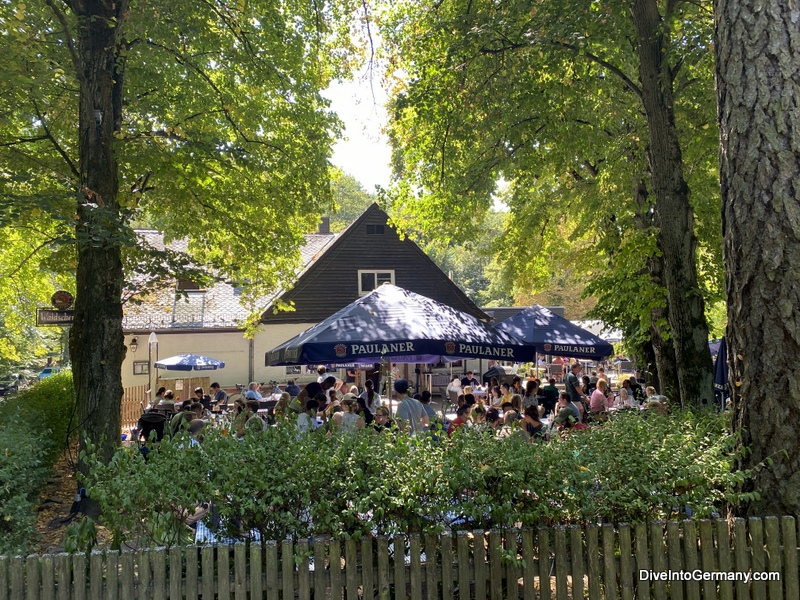
The perfect way to finish a visit here is definitely to stop in at a restaurant. Heiligenberg has the perfect option – Waldschenke Heidelberg Gasthaus mit Biergarten. In fact, it’s the only option around this site, so thankfully it’s a good one!
This beer garden has a good range of food and drinks and a beautiful garden (as well as an inside area) to sit and enjoy them in. It’s especially nice to visit here on a nice day, but either way, it’s a top option.
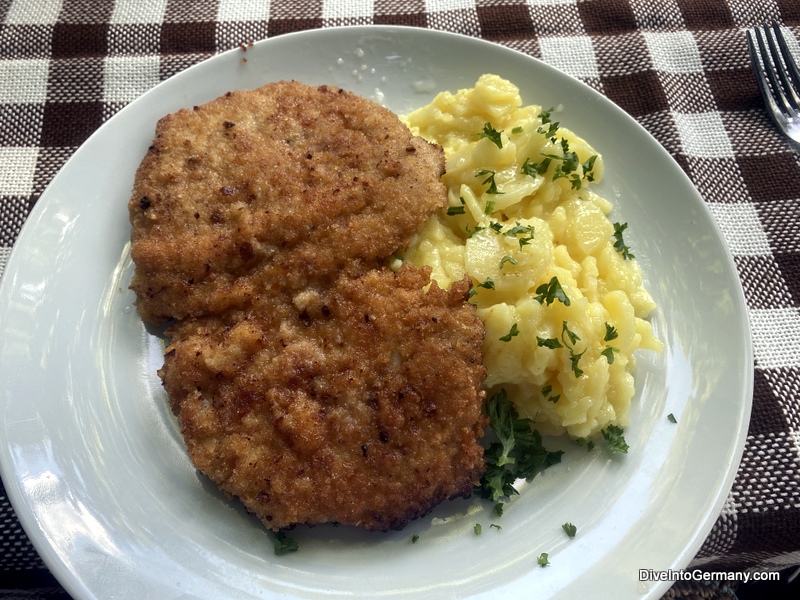
We very much enjoyed eating lunch here after a morning exploring Heiligenberg.
You can reserve a table on the link above. We visited for a Sunday lunch in August and it was busy, but people who didn’t book still didn’t wait too long for a table.
Heiligenberg Location (And Getting There)
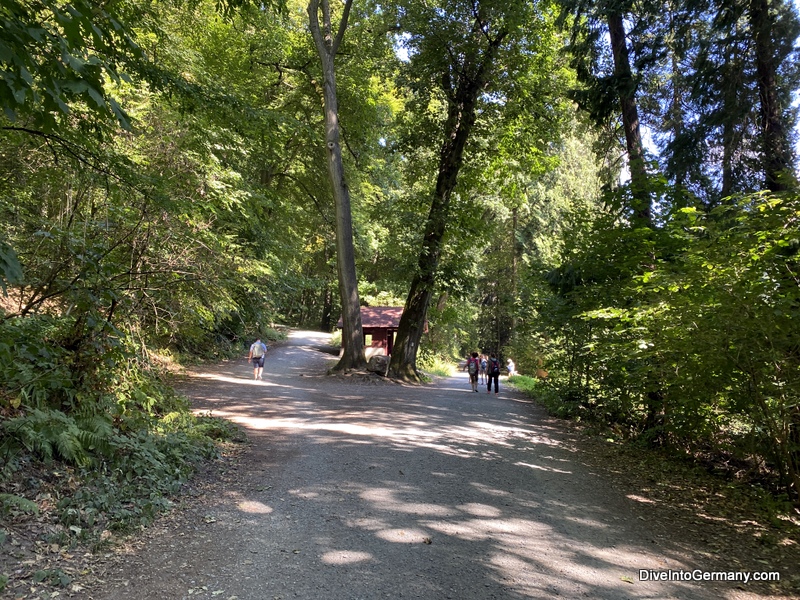
Heiligenberg is located on the hill opposite Heidelberg’s Old Town across the river. It doesn’t look that exciting from the Old Town, but as you now know, there is plenty to see when you get there.
The best way to get here is to walk. You can reach it via the Philosopher’s Way and/or there are paths from the Old Bridge across the Neckar River.
While you are walking up a hill, the majority of the walk is not that strenuous. However, some parts are quite tough. The toughest part is reaching the Philosopher’s Way up Schlangenweg (Snake Path). Thankfully, that is over quickly!
You don’t need to be super fit but you do need to be able to walk around for a couple of hours and handle walking up and down hills. I have a bad ankle and did it fine (but wouldn’t say it was easy). We also did it with our three kids aged 6, 10 and 12 and they did it fine.
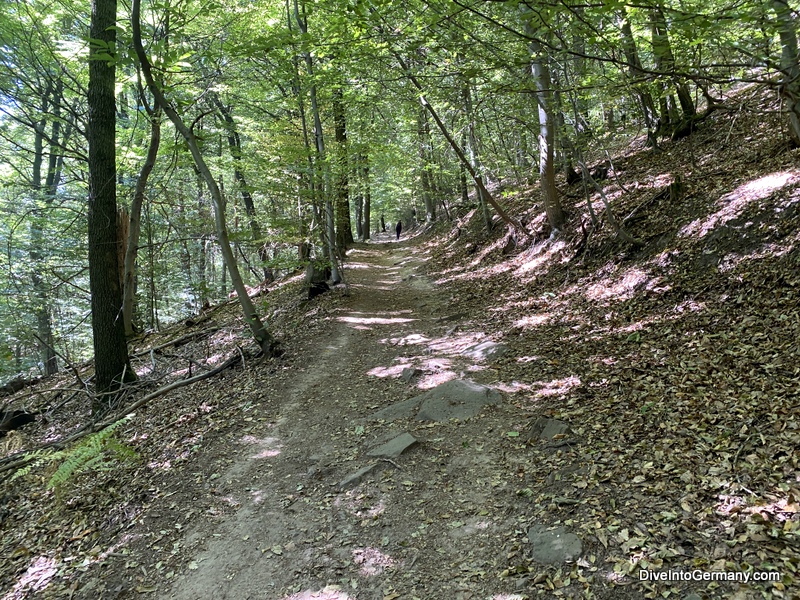
The hardest part is working out which way to go. There are some signs, but they aren’t very good. Google maps is definitely the way to go and make sure you keep following it – it’s really easy to walk the wrong way even looking at the map. We walked the wrong way several times.
I considered showing photos of every turn in this article, but I think it’d still be easy to get confused. Follow Google maps and make sure your blue dot keeps going the right way and you’ll be fine.

Thankfully, it is a beautiful area and we very much enjoyed the walk up there and back down again. I highly recommend you walk it.
Combined with walking the Philosopher’s Way as well as a lazy lunch (find the details here as well as more instructions for walking up the Snake Path and getting to the trail up to Heiligenberg), this was a nice day trip that we very much enjoyed. You could also do it in a quicker half day or even a couple of hours if you really rushed (but I don’t recommend the latter – you wouldn’t have time to look around properly).
It is also possible to drive and park up here, but don’t do it! The walk is nice 🙂
There is plenty of parking near the restaurant. This is close to the four attractions above and you can walk around them fairly fast. You’ll still need to be able bodied enough to walk over gravel and rough ground although reaching the first three attractions is fairly smooth.
There are also buses up here.

Heiligenberg Entry Fee?
There is no entry fee to visit Heiligenberg mountain and all the attractions here.
Final Words
Visiting Heiligenberg, especially on foot, is a great way to see more and appreciate more of Heidelberg. We very much enjoyed our hours here walking up, exploring the sites and enjoying a long lunch and a beer in the beer garden.
It’s a nice contrast to visiting museums and Heidelberg Castle. I highly recommend it.
Looking for more? You can also find our full guide to Heidelberg here, accommodation options in Heidelberg here and all our guides to travelling southern Germany here.
